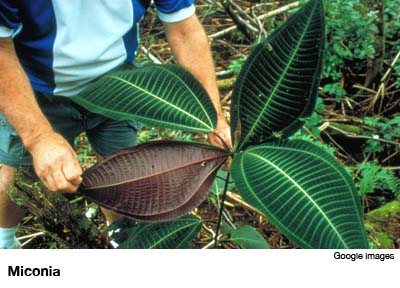Like aliens in a horror movie, the velvet tree of Mexico and whistling frog of Puerto Rico are viewed as monster invaders on the Hawaiian Islands, repulsive things that threaten the native forests and disturb the locals’ peace of mind.
In a state with 5,300 invasive species, the most feared is miconia aka “the purple plague” and “the tree that ate Tahiti.” Its huge purple and green leaves layer two stories high, blocking the sun and snuffing out the mosses and ferns below. Unlike other trees, miconia cannot hold the soil. On Tahiti, it is a “green cancer” that has taken over 75 percent of the native forests, leading to major landslides.
Public enemy No. 2 in Hawaii is the coquí, a quarter-sized tree frog aka “the new cockroach.” In the mating season, a chorus of frogs shrilly crying “ko-KEE” in the middle of the night can be louder than a vacuum cleaner. Real estate agents are required to disclose the presence of the alien creature to prospective buyers. Hotels have received distress calls from guests to “turn off the damned frogs.”
The coquí is a beloved icon in its native Puerto Rico, where it is kept in check by birds, snakes and giant spiders. In Hawaii, with no major predators, the frogs have proliferated, and they’re robbing the natives of a good night’s sleep.

“Two or three in the distance is very nice,” said Dave Duffy, a botany professor at the University of Hawaii at Manoa. “Ten thousand of them in your backyard are sort of like a rock band. It’s as if you had cicadas on steroids. People burn their backyards. They burn their neighborhoods down. They shoot their trees with shotguns.”
Some Hawaiians have found a better way to take matters into their own hands. In a recent study for the Journal for Nature Conservation, Duffy and Fred Kraus, a zoologist at the Bishop Museum in Honolulu, tell how, for more than 10 years, volunteer “invasive species committees” (or ISCs) on six of the eight main Hawaiian islands have pulled together scientists, ranchers, nursery owners and lower-level state and federal officials to save Hawaii’s natural paradise.
They’ve learned the hard way, from miconia, that an early, rapid response to exotic pests is key, said Kraus, one of the founders.
“The longer you delay, the less likely you are to succeed,” he said. “You want to look for new invasions so you can nip them in the bud.”
Trouble in Paradise
Hawaii has more invasive species than any other state in the United States. Of the 5,300 aliens now established on the islands, between 300 and 500 are spreading widely. Most are weeds. Botanists have identified as many as 90 newcomers in one year. They hitchhike in on container ships and planes, luggage, clothing, fruits and vegetables, or they come in legally in the largely unregulated nursery trade. Many of the animals are smuggled in as pets.
“We’ve got invasions very close at hand, all around us, weeds, pigs, earthworms, ants — all sorts of ecological disrupters,” Kraus said. “There’s no way to get away from it. It’s an immense problem.”
For sheer diversity, Hawaii’s plants and animals exceed those of the Galápagos Islands. Most of them are found only in Hawaii. But the state also has a reputation as the “extinction capital of the U.S.” The loss of wild habitat to farming and development used to be the big villain. Now the culprits are invasive plants that choke out the native vegetation.
By the time an exotic plant, insect, bird or amphibian makes it inland to a state or federal forest where a government agency might take action, it likely has already spread out of control, scientists say.
Meanwhile, they say, the bureaucratic response can aid the invaders. Governments must put their projects out to bid, and that takes a long time; official eradications typically stop at the boundaries of a park or military base. Bilateral agreements can take years, and a host of overlapping responsibilities often means no one is in charge.
“Invasive species don’t respect whether you’re on private property or national park or state land,” Duffy said. “There’s just this flood of stuff coming in and no commitment by the government to stop it.”
“All in a handshake”
Unlike government agencies, the invasive species committees have no legal standing or enforcement powers. And that may explain why they have a high success rate with private landowners, scientists say. Property owners who might have filed a lawsuit if the federal government had requested entry are often willing to work with a group that operates outside official channels. Private land comprises most of the state and is where most of the new invaders are found.
For each committee, the university hires a staff and a search-and-destroy field crew, ranging in size from five people, as on Kauai, to 30 people, as on Maui. They must be willing to toil in rough terrain and work flexible hours, including nights.
Maui’s crews have gone door-to-door in Maui’s residential neighborhoods, killing banana trees that are infested with an aphid-borne virus. They’ve driven up and down the roads, looking for new plant invaders and noting their location by GPS. In this way, they have been able to “defeat” eight out of 27 target species, most of which are plants.
“It’s like weeding your garden,” said Teya Penniman, manager of the Maui committee. “For us, the garden is the whole island. If we lose the native forest, we lose our watershed and the ability to sustain life.”
The committees enjoy broad popular support. Coquí frogs are widely viewed as a menace in Hawaii; even most animal rights groups don’t oppose their extermination.
The funding comes from county, state and federal governments and private foundations, and is managed by the university. Between 2005 and this year, it ranged from an average $490,000 per year on Oahu to an average $1.8 million on Maui. In 2006, the entire budget for the committees was $2.6 million, compared to $47 million in government spending for eradication and weed control, much of it on public land.
“The ISCs are very efficient compared to the much larger budget the government has,” Duffy said. “They’re more agile. We trust them to do what they say they’re going to do. In some ways, it’s all in a handshake.”
Informal diplomacy comes in handy when a crew stumbles on nudity, a pot farm or illegal buildings, Penniman said.
“We make it clear we’re not interested in whether they have clothes on or not,” Penniman said. “We don’t really ‘exist.’ We’re not a state agency. We’re not a nonprofit. We don’t have a stick, but sometimes that’s a benefit. …We’ve been successful in making our case with the public.”
Mixed results
Mark Rauzon, an Oakland, Calif.-based expert in island restoration in the tropical Pacific Ocean, says Hawaii’s committees are helping to transcend “bureaucratic top-heaviness and malaise” in a state with limited access, organization and funding for conservation.
“It is a path forward through a thorny set of issues,” Rauzon said.
But all-out victories remain few and far between.
“If you can’t catch invasives in the initial phase, especially on a big island, they have more places to run away,” Duffy said. “In some places, we were just too late in the curve.”
Thus, he said, Kauai and Oahu may be able to completely eradicate miconia, but containment may be the only possible goal on Maui and the island of Hawaii. Complicating matters on the Big Island are absentee owners who don’t respond to committee requests for access. Marijuana growers often refuse to allow in the eradication crews, Duffy said. Law enforcement helicopters regularly patrol for marijuana on the Big Island.
On Maui, a crew of seven native Hawaiians works full-time, searching the forests for miconia. They hike up and down ravines and hack through the vegetation with machetes. They uproot small trees and apply a thin line of herbicide around the stalks of larger trees. Helicopters search for miconia several times a week, hovering over each tree and surgically applying a small amount of herbicide.

During the past 12 months, Maui’s crews have killed 110,000 miconia trees on a total 11 acres — but miconia are present on about 2,500 acres.
At night, another crew on Maui goes out to listen for coquí. Sometimes they find them in unlikely places, such as junkyards and nurseries. They spray them with diluted citric acid to kill them, and they return repeatedly to make sure that they haven’t missed any frogs. In the Maliko Gulch, a 3-mile-long frog-infested ravine on the north shore of Maui, workers are engaged in an all-out assault with fire hoses to conduct the spraying.
“You go back, go back, go back, go back and go back, and eventually you get them,” Penniman said. “One year without noise means no frogs.”
Eight of 14 coquí populations have been liquidated on Maui. The frogs have been eliminated on Oahu and Molokai and nearly eliminated on Kauai. But, by some estimates, there are a million frogs living on 60,000 acres on the Big Island. It would cost $200 million dollars to spray them even once.
This fall, the County of Hawaii announced that budget cuts would force it to abandon coquí eradication. The county’s chemical spray rigs will be auctioned off next April.
“The funding has dried up,” Duffy said. “Each year it gets worse.”
And that’s just fine with the Coquí Frog Sanctuary and Nature Preserve in Pahoa, Hawaii, one of a handful of places in the state that tolerates the frogs. By special invitation, tourists are allowed on the property to hear their “sunset serenade.”
Sydney Ross Singer, executive director of the Good Shepherd Foundation, the property owner, would like to see the Invasive Species Committees disbanded. He views the war on frogs as cruel, barbaric and futile.
“The checks and balances are gone because everybody’s on one team,” Singer said. “They have a monopoly and they come out with unscientific agendas. They exaggerated the numbers and the whole decibel business. Hawaii is the first and only place in the world where a tree frog is called an agricultural pest.”
Sign up for our free e-newsletter.
Are you on Facebook? Become our fan.
Follow us on Twitter.




